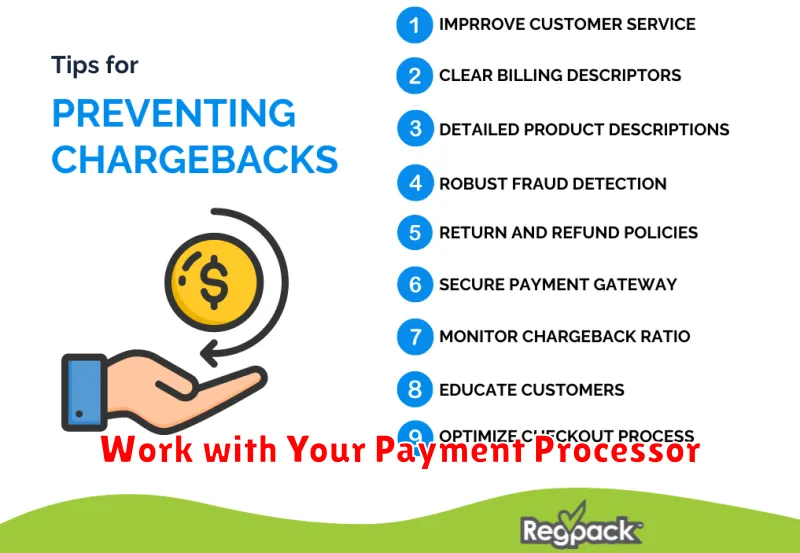In today’s competitive e-commerce landscape, online businesses face the constant challenge of minimizing chargebacks while simultaneously maximizing sales. Chargebacks, those unwelcome reversals of credit card transactions, can significantly impact profitability, damage merchant reputation, and even lead to account termination. This article delves into proven strategies that empower online businesses to effectively combat chargebacks, optimize the customer experience, and ultimately boost sales. Learn how to implement proactive measures to prevent chargebacks before they occur, understand the underlying causes of disputes, and develop effective representment strategies to recover lost revenue.
From implementing robust fraud prevention measures to enhancing communication with customers, the strategies outlined in this article offer actionable insights to mitigate chargeback risks and improve overall business performance. Discover how to strengthen your customer service protocols, optimize your product descriptions and delivery processes, and leverage data-driven analytics to identify trends and proactively address potential chargeback triggers. By understanding and addressing the root causes of chargebacks, you can create a more secure and seamless customer experience, leading to increased customer satisfaction, higher conversion rates, and sustained sales growth.
Understanding the Chargeback Process
A chargeback occurs when a cardholder disputes a transaction with their issuing bank, effectively reversing the payment. This process is designed to protect consumers from unauthorized or fraudulent transactions. Understanding this process is crucial for online businesses to effectively manage and minimize chargebacks.
The chargeback process typically involves several key steps:
- Dispute Filed: The cardholder contacts their bank to dispute a charge.
- Notification to Merchant: The acquiring bank notifies the merchant of the dispute.
- Evidence Submission: The merchant has a limited time to provide compelling evidence to refute the chargeback (e.g., proof of delivery, customer authorization).
- Bank Review: The issuing bank reviews the evidence provided by both parties.
- Decision: The issuing bank makes a decision in favor of either the cardholder or the merchant.
- Chargeback Reversal (Representment): If the merchant disagrees with the decision, they can challenge it through a representment process.
Each step has specific timeframes and requirements, and failing to adhere to them can result in a lost chargeback and lost revenue.
Common Reasons for Chargebacks
Understanding the common reasons behind chargebacks is crucial for implementing effective preventative measures. Chargebacks can stem from a variety of issues, impacting both the customer and the merchant. Here are some of the most frequent causes:
Unauthorized Transactions
Fraudulent Purchases: This occurs when a stolen credit card or compromised account is used to make a purchase without the cardholder’s authorization. This is a significant concern for online businesses.
Friendly Fraud: This happens when a legitimate cardholder makes a purchase and then initiates a chargeback, falsely claiming they didn’t authorize the transaction. This is often done to avoid paying for a product or service.
Merchant Error
Processing Errors: Incorrect transaction amounts, duplicate processing, or other processing errors can lead to chargebacks.
Product/Service Issues: The customer may initiate a chargeback if the product received is significantly different from what was advertised, damaged, or not delivered at all.
Unclear Billing Descriptors: If the descriptor on the customer’s credit card statement isn’t recognizable, they may dispute the charge.
Implement Strong Customer Authentication (SCA)
Strong Customer Authentication (SCA) is a crucial element in reducing chargebacks and building customer trust. SCA adds an extra layer of security to online transactions, making it significantly more difficult for fraudulent purchases to occur. This process typically involves two-factor authentication (2FA), requiring customers to verify their identity through two distinct methods.
Common 2FA methods include one-time passwords (OTPs) sent via SMS, email, or authenticator apps, as well as biometric verification like fingerprint or facial recognition. By implementing SCA, businesses can significantly reduce the risk of unauthorized transactions, thereby minimizing chargeback disputes related to fraud. This added security measure reassures customers that their financial information is protected, leading to increased confidence in the online store.
Key benefits of SCA include:
- Reduced fraud and chargebacks
- Improved customer trust and confidence
- Compliance with payment regulations (e.g., PSD2 in Europe)
Provide Exceptional Customer Service
Proactive communication and readily available support channels are crucial for minimizing chargebacks. Customers who can easily reach out with questions or concerns are less likely to resort to a chargeback.
Offer multiple contact options such as email, phone, and live chat. Ensure prompt responses and efficient resolution of customer issues. A dedicated customer support team trained to handle chargeback-related inquiries can significantly impact your success rate in preventing them.
Personalized support can further enhance the customer experience. Addressing customers by name and referencing their purchase history demonstrates attentiveness and builds rapport. This personalized approach can diffuse potential disputes before they escalate into chargebacks.
Invest in self-service resources like FAQs and knowledge bases. Empowering customers to find answers independently can reduce the strain on your support team and provide immediate solutions to common inquiries.
Clear and Concise Refund Policies

A well-defined and easily accessible refund policy is crucial for minimizing chargebacks. Clarity is key. Customers should easily understand the conditions under which they can receive a refund, the process involved, and the timeframe for processing.
Use plain language, avoiding legal jargon or complex terminology. Clearly state the accepted reasons for refunds, such as damaged goods, incorrect items, or dissatisfaction with a service. Specify any time limits for requesting a refund, for example, “within 30 days of purchase.”
Transparency builds trust. Make your refund policy easily accessible on your website. Consider including it in the footer, FAQ section, and product pages. Providing a dedicated “Refund Policy” page is also a best practice.
Pro Tip: Offer multiple refund options, such as original payment method refunds or store credit, to enhance customer satisfaction and potentially reduce chargeback requests.
Address Verification System (AVS) and Card Security Code (CSC)
Implementing AVS and CSC checks during the checkout process is a fundamental step in preventing fraudulent transactions and subsequently reducing chargebacks. AVS compares the billing address provided by the customer with the address on file with the card issuer. Any discrepancies can indicate potential fraud.
CSC, on the other hand, is a three or four-digit security code located on the back of most credit and debit cards. Requiring this code helps verify that the person making the purchase has physical possession of the card. By using both AVS and CSC checks, you add an extra layer of security and significantly reduce the risk of processing fraudulent orders.
While these checks are not foolproof, they act as a powerful deterrent and can help identify potentially fraudulent transactions before they are processed. This proactive approach minimizes the likelihood of chargebacks and protects your business from financial losses.
Monitor Transactions and Identify Suspicious Activity
Proactive transaction monitoring is crucial for identifying potentially fraudulent activity before it escalates into a chargeback. Regularly review transactions for unusual patterns that may indicate fraud.
Look for red flags such as:
- Large orders placed from new customers.
- Multiple orders shipped to the same address with different billing information.
- Orders with international shipping addresses, especially if your business typically serves a local customer base.
- Sudden increases in transaction volume from a particular region or IP address.
Implement a real-time fraud detection system that can automatically flag suspicious transactions based on predetermined criteria. This can help you quickly identify and address potential issues before they result in chargebacks.
Promptly investigate any suspicious activity and take appropriate action, such as contacting the customer or canceling the order. By taking a proactive approach, you can significantly reduce your chargeback ratio and protect your business from financial losses.
Maintain Detailed Transaction Records
Meticulous record-keeping is paramount in combating chargebacks. Maintaining comprehensive transaction records provides crucial evidence when disputing chargebacks and helps identify trends that may indicate fraudulent activity. This documentation should be easily accessible and well-organized for quick retrieval.
Key data points to retain for each transaction include:
- Date and time of purchase
- Transaction amount
- Customer’s name and billing address
- Shipping address (if applicable)
- IP address of the customer
- Payment method used
- AVS and CSC match results
- Tracking information for shipped goods
- Any communication with the customer related to the order
By maintaining these detailed records, you equip yourself with the necessary information to effectively challenge invalid chargebacks and protect your revenue.
Work with Your Payment Processor

Your payment processor is a key ally in the fight against chargebacks. They possess valuable tools and expertise that can significantly reduce your chargeback ratio.
Proactively communicate with your processor. Discuss your chargeback concerns and inquire about specific services they offer to help mitigate them. Many processors provide fraud prevention tools, such as velocity checks and address verification services, that can identify and flag suspicious transactions before they result in chargebacks.
Collaborate with your processor to understand chargeback reason codes and trends. This information can help you pinpoint vulnerabilities in your sales process and implement effective countermeasures. Your processor can also provide guidance on compiling compelling representment documentation, increasing your chances of winning chargeback disputes.
Finally, explore chargeback alert systems or other real-time notification services offered by your processor. These alerts can provide immediate notification of filed chargebacks, enabling you to address the issue promptly and potentially resolve it before it escalates.
Stay Up-to-Date with Chargeback Regulations
The regulatory landscape for chargebacks is constantly evolving. Staying informed about current rules and upcoming changes is crucial for minimizing risk. Regularly review updates from card networks like Visa and Mastercard, as well as regulations specific to your industry and region.
Understanding the nuances of chargeback reason codes is also essential. Knowing the specific reasons behind chargebacks allows you to address the root causes effectively and implement preventative measures. This knowledge empowers you to challenge invalid chargebacks with supporting documentation and a strong case.
Subscribe to industry newsletters and alerts to stay informed about changes in regulations and best practices. This proactive approach will help you adapt to evolving requirements and avoid potential penalties associated with non-compliance. Being aware of shifting regulations can also reveal opportunities to optimize your processes and strengthen your chargeback defense strategy.

